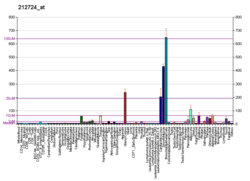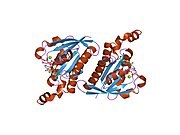Protein-coding gene in the species Homo sapiens
| RND3 |
|---|
 |
| Available structures |
|---|
| PDB | Ortholog search: PDBe RCSB |
|---|
| List of PDB id codes |
|---|
1M7B, 2V55, 4BG6 |
|
|
| Identifiers |
|---|
| Aliases | RND3, ARHE, Rho8, RhoE, memB, Rnd3, Rho family GTPase 3 |
|---|
| External IDs | OMIM: 602924; MGI: 1921444; HomoloGene: 21074; GeneCards: RND3; OMA:RND3 - orthologs |
|---|
| Gene location (Human) |
|---|
 | | Chr. | Chromosome 2 (human)[1] |
|---|
| | Band | 2q23.3 | Start | 150,468,195 bp[1] |
|---|
| End | 150,539,011 bp[1] |
|---|
|
| Gene location (Mouse) |
|---|
 | | Chr. | Chromosome 2 (mouse)[2] |
|---|
| | Band | 2|2 C1.1 | Start | 51,020,450 bp[2] |
|---|
| End | 51,039,123 bp[2] |
|---|
|
| RNA expression pattern |
|---|
| Bgee | | Human | Mouse (ortholog) |
|---|
| Top expressed in | - amniotic fluid
- stromal cell of endometrium
- oral cavity
- mucosa of pharynx
- urethra
- mucosa of urinary bladder
- cervix epithelium
- ganglionic eminence
- human penis
- lactiferous duct
|
| | Top expressed in | - genital tubercle
- medial ganglionic eminence
- tunica media of zone of aorta
- molar
- calvaria
- mandibular prominence
- cornea
- atrioventricular valve
- maxillary prominence
- dermis
|
| | More reference expression data |
|
|---|
| BioGPS |  | | More reference expression data |
|
|---|
|
| Gene ontology |
|---|
| Molecular function | - nucleotide binding
- GTP binding
- protein binding
- GTPase activity
- protein kinase binding
| | Cellular component | - Golgi membrane
- Golgi apparatus
- extracellular exosome
- membrane
- focal adhesion
- intracellular anatomical structure
- cytoplasm
- plasma membrane
- cell cortex
- cell division site
- intracellular membrane-bounded organelle
| | Biological process | - small GTPase mediated signal transduction
- cell adhesion
- actin cytoskeleton organization
- actin filament organization
- Rho protein signal transduction
- regulation of cell shape
- regulation of cell migration
- establishment or maintenance of actin cytoskeleton polarity
- regulation of actin cytoskeleton organization
- actin filament bundle assembly
| | Sources:Amigo / QuickGO |
|
|
| Wikidata |
| View/Edit Human | View/Edit Mouse |
|
Rnd3 is a small (~21 kDa) signaling G protein (to be specific, a GTPase), and is a member of the Rnd subgroup of the Rho family of GTPases.[5] It is encoded by the gene RND3.[6]
Like other members of the Rho family of Ras-related GTPases it regulates the organization of the actin cytoskeleton in response to extracellular growth factors.
Regulation
Most Rho family members cycle between an inactive GDP-bound form and an active GTP-bound form. However, members of the Rnd subgroup of the Rho family are exceptions to this, binding detectably only to GTP, while having low GTPase activity, if any.[7] Instead, Rnd family proteins are regulated through other mechanisms that control their production, degradation, phosphorylation, and localization.[8]
Interactions
In its GTP-bound form, RhoA exposes regions that allow it to interact with downstream targets. Rnd3 contains a region which is similar to the one RhoA exposes for interaction with ROCK1, allowing Rnd3 to compete with RhoA for interaction with ROCK1. By binding to ROCK1, Rnd3 inhibits it from phosphorylating downstream targets necessary for stress fiber formation. Rnd3 is also directly involved in controlling RhoA activity through suppression of PLEKHG5[9] and activation of ARHGAP5.[10] Interaction with UBXD5 has also been shown.[11]
References
- ^ a b c GRCh38: Ensembl release 89: ENSG00000115963 – Ensembl, May 2017
- ^ a b c GRCm38: Ensembl release 89: ENSMUSG00000017144 – Ensembl, May 2017
- ^ "Human PubMed Reference:". National Center for Biotechnology Information, U.S. National Library of Medicine.
- ^ "Mouse PubMed Reference:". National Center for Biotechnology Information, U.S. National Library of Medicine.
- ^ Ridley AJ (October 2006). "Rho GTPases and actin dynamics in membrane protrusions and vesicle trafficking". Trends in Cell Biology. 16 (10): 522–9. doi:10.1016/j.tcb.2006.08.006. PMID 16949823.
- ^ "Entrez Gene: RND3 Rho family GTPase 3".
- ^ Riento K, Guasch RM, Garg R, Jin B, Ridley AJ (June 2003). "RhoE binds to ROCK I and inhibits downstream signaling". Molecular and Cellular Biology. 23 (12): 4219–29. doi:10.1128/MCB.23.12.4219-4229.2003. PMC 156133. PMID 12773565.
- ^ Chardin P (January 2006). "Function and regulation of Rnd proteins". Nature Reviews. Molecular Cell Biology. 7 (1): 54–62. doi:10.1038/nrm1788. PMID 16493413. S2CID 90941.
- ^ Goh LL, Manser E (August 2010). Ouchi T (ed.). "The RhoA GEF Syx is a target of Rnd3 and regulated via a Raf1-like ubiquitin-related domain". PLOS ONE. 5 (8): e12409. Bibcode:2010PLoSO...512409G. doi:10.1371/journal.pone.0012409. PMC 2928299. PMID 20811643.
- ^ Wennerberg K, Forget MA, Ellerbroek SM, Arthur WT, Burridge K, Settleman J, et al. (July 2003). "Rnd proteins function as RhoA antagonists by activating p190 RhoGAP". Current Biology. 13 (13): 1106–15. Bibcode:2003CBio...13.1106W. doi:10.1016/S0960-9822(03)00418-4. PMC 6918695. PMID 12842009.
- ^ Katoh H, Harada A, Mori K, Negishi M (May 2002). "Socius is a novel Rnd GTPase-interacting protein involved in disassembly of actin stress fibers". Molecular and Cellular Biology. 22 (9): 2952–64. doi:10.1128/MCB.22.9.2952-2964.2002. PMC 133765. PMID 11940653.
Further reading
- Foster R, Hu KQ, Lu Y, Nolan KM, Thissen J, Settleman J (June 1996). "Identification of a novel human Rho protein with unusual properties: GTPase deficiency and in vivo farnesylation". Molecular and Cellular Biology. 16 (6): 2689–99. doi:10.1128/MCB.16.6.2689. PMC 231259. PMID 8649376.
- Bonaldo MF, Lennon G, Soares MB (September 1996). "Normalization and subtraction: two approaches to facilitate gene discovery". Genome Research. 6 (9): 791–806. doi:10.1101/gr.6.9.791. PMID 8889548.
- Nobes CD, Lauritzen I, Mattei MG, Paris S, Hall A, Chardin P (April 1998). "A new member of the Rho family, Rnd1, promotes disassembly of actin filament structures and loss of cell adhesion". The Journal of Cell Biology. 141 (1): 187–97. doi:10.1083/jcb.141.1.187. PMC 2132722. PMID 9531558.
- Katoh H, Harada A, Mori K, Negishi M (May 2002). "Socius is a novel Rnd GTPase-interacting protein involved in disassembly of actin stress fibers". Molecular and Cellular Biology. 22 (9): 2952–64. doi:10.1128/MCB.22.9.2952-2964.2002. PMC 133765. PMID 11940653.
- Fiegen D, Blumenstein L, Stege P, Vetter IR, Ahmadian MR (August 2002). "Crystal structure of Rnd3/RhoE: functional implications". FEBS Letters. 525 (1–3): 100–4. doi:10.1016/S0014-5793(02)03094-6. PMID 12163169. S2CID 24691079.
- Riento K, Guasch RM, Garg R, Jin B, Ridley AJ (June 2003). "RhoE binds to ROCK I and inhibits downstream signaling". Molecular and Cellular Biology. 23 (12): 4219–29. doi:10.1128/MCB.23.12.4219-4229.2003. PMC 156133. PMID 12773565.
- Wennerberg K, Forget MA, Ellerbroek SM, Arthur WT, Burridge K, Settleman J, et al. (July 2003). "Rnd proteins function as RhoA antagonists by activating p190 RhoGAP". Current Biology. 13 (13): 1106–15. Bibcode:2003CBio...13.1106W. doi:10.1016/S0960-9822(03)00418-4. PMC 6918695. PMID 12842009.
- Bektic J, Pfeil K, Berger AP, Ramoner R, Pelzer A, Schäfer G, et al. (September 2005). "Small G-protein RhoE is underexpressed in prostate cancer and induces cell cycle arrest and apoptosis". The Prostate. 64 (4): 332–40. doi:10.1002/pros.20243. PMID 15754346. S2CID 20256303.
- Rubenstein NM, Chan JF, Kim JY, Hansen SH, Firestone GL (April 2005). "Rnd3/RhoE induces tight junction formation in mammary epithelial tumor cells". Experimental Cell Research. 305 (1): 74–82. doi:10.1016/j.yexcr.2004.12.010. PMID 15777789.
- Benzinger A, Muster N, Koch HB, Yates JR, Hermeking H (June 2005). "Targeted proteomic analysis of 14-3-3 sigma, a p53 effector commonly silenced in cancer". Molecular & Cellular Proteomics. 4 (6): 785–95. doi:10.1074/mcp.M500021-MCP200. PMID 15778465.
- Kim YS, Hori M, Yasuda K, Ozaki H (December 2005). "Differences in the gestational pattern of mRNA expression of the Rnd family in rat and human myometria". Comparative Biochemistry and Physiology. Part A, Molecular & Integrative Physiology. 142 (4): 410–5. doi:10.1016/j.cbpa.2005.08.028. PMID 16311049.
- Ongusaha PP, Kim HG, Boswell SA, Ridley AJ, Der CJ, Dotto GP, et al. (December 2006). "RhoE is a pro-survival p53 target gene that inhibits ROCK I-mediated apoptosis in response to genotoxic stress". Current Biology. 16 (24): 2466–72. Bibcode:2006CBio...16.2466O. doi:10.1016/j.cub.2006.10.056. PMC 2779528. PMID 17174923.
- Poch E, Miñambres R, Mocholí E, Ivorra C, Pérez-Aragó A, Guerri C, et al. (February 2007). "RhoE interferes with Rb inactivation and regulates the proliferation and survival of the U87 human glioblastoma cell line". Experimental Cell Research. 313 (4): 719–31. doi:10.1016/j.yexcr.2006.11.006. PMID 17182035.
 | This article on a gene on human chromosome 2 is a stub. You can help Wikipedia by expanding it. |

 1gwn: THE CRYSTAL STRUCTURE OF THE CORE DOMAIN OF RHOE/RND3 - A CONSTITUTIVELY ACTIVATED SMALL G PROTEIN
1gwn: THE CRYSTAL STRUCTURE OF THE CORE DOMAIN OF RHOE/RND3 - A CONSTITUTIVELY ACTIVATED SMALL G PROTEIN 1m7b: Crystal structure of Rnd3/RhoE: functional implications
1m7b: Crystal structure of Rnd3/RhoE: functional implications





















